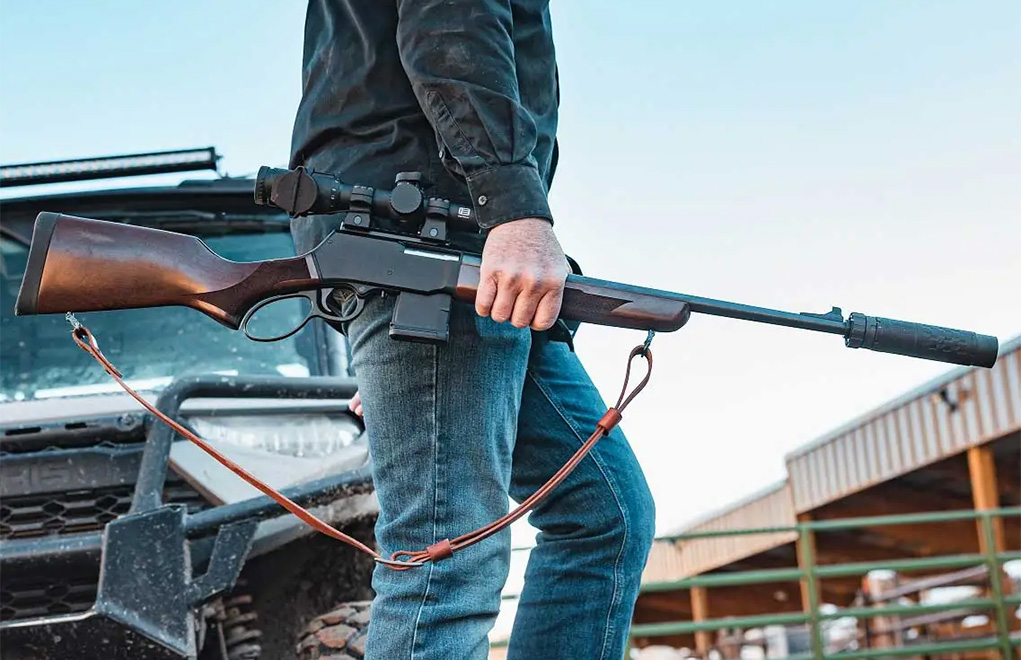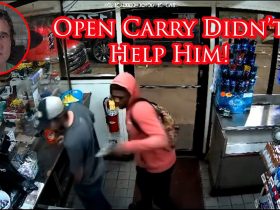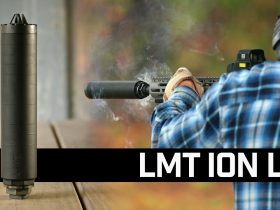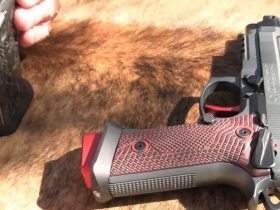There is a question in the self-defense community about the role of handguns, often breaking down into two camps: deterrence or defense? Is a handgun, carried in public, better employed as “deterrence” (drawing or pointing with no immediate intention of firing) or is it only a tool of “defense” (by drawing with the intention of firing)?
First off, let’s agree that firearms are merely tools. Handguns, like all firearms, are not magical wards against all forms of danger from predators, whether two or four-legged. Like chain saws, power tools and automobiles, when used carelessly or maliciously, people can be accidentally or illegally harmed. If you grew up with my father, you’d know that every tool is built for a specific purpose. For instance, using a hammer to drive screws was a serious error; using the proper saw blade for ripping or crosscutting lumber was essential, while using a knife as a tool with which to pry was nearly a capital offense.
A handgun carried in public—especially when concealed—fulfills a specific, limited task, like any tool. The difference between firearms and almost all other tools is that misuse often results in significant legal jeopardy. Sometimes the misuse of a firearm results from the desire to avoid a shooting.
Even those who live in generally “firearm-friendly” states have counties where the population is hostile to firearms. We cannot always count on traditional values and the fair enforcement of laws by our governments. So, what is the primary purpose of a concealed handgun when considering the political and legal realities we face as lawfully armed citizens?
How we think about the purpose of our firearms determines how we will likely use our tools. They can either keep us safer or imperil us, depending upon how we employ them. Let’s agree that “being safer” means stopping someone from inflicting serious physical injury or death while simultaneously not going to prison through misuse of our firearms in our defense. Wait, do I hear the “… tried by 12 rather than carried by six” chant beginning? It’s a catchy slogan and partly true, but anyone casually believing this has never been through the peril and utter exhaustion of criminal and civil trials as a defendant. And if you’re a defendant, even though you believe you “did everything right,” there is always a very real chance of conviction. Even if you are found innocent, you are still responsible for legal representation and court fees.
In most instances, firearms can only be used when life-threatening violence is imminent.
The “Deterrence Camp”
“I don’t want to shoot anybody! Isn’t it better just to let someone who was threatening me know that I have a gun? Maybe pointing it at them will make them stop before anyone gets hurt.”
First, no one in their right mind seriously wants to shoot anybody. Setting the inevitable legal nightmare aside for the moment, shooting someone causes severe bodily injury, often resulting in lifelong disability. Or, worse, that person could die. Those who have been forced to shoot in defense of life report they relive the shooting over and over for months, years—sometimes for the rest of their lives. Lives change. People, including family, will look at us differently, and some we love may drift out of our lives as a result. Shooting someone is only an option when responding to extreme, life-threatening behavior.
Is a handgun, carried in public, better employed as “deterrence” (drawing or pointing with no immediate intention of firing) or is it only a tool of “defense” (by drawing with the intention of firing)?
While we think of ourselves as the “good guys,” there is also the very real legal peril of being convicted (which is always more than a zero chance, regardless of where we live). We may also lose a civil lawsuit (again, much more than a zero chance of losing everything we’ve worked for). There’s also the cost associated with your legal defense, whether successful or not.
Because we don’t want to shoot anyone, some believe that making it known we’re armed by drawing and/or pointing a handgun at someone whose behavior is threatening is a form of de-escalation. It tells the offender to stop, to back off, to leave us alone or else. After all, “If someone pointed a gun at me, I’d change my behavior immediately because I don’t want to be shot. In doing so, everyone’s lives are protected, and a potential shooting is averted. So, I’m good, right?”
Drawing, displaying or pointing a firearm at another person in a threatening, careless or rude manner is interpreted as a threat of being shot. The legal system, the police and the courts automatically become involved in the incident because this is a crime, minimally, of “brandishing,” “illegally displaying,” “improper exhibition” or some other term of legalese. Historically, if not thoroughly and obviously justified within the circumstances, this action has been criminally prosecuted.
“Wait a minute!” you cry out, “Police officers often point handguns at people when responding to calls where there may be a danger of violence and it is unknown if the subjects are armed.” They do. Still, officers must act reasonably when pointing their firearms. Because their job is to willingly seek out criminals, they are trained to first select the most effective force option in threatening circumstances by drawing and pointing a firearm at possible suspects. Once it’s apparent deadly force is not necessary, officers are required to transition to a less-injurious force option. Non-police officers, including retired officers, do not enjoy that privilege and are held to a much higher standard when exhibiting a firearm. An unjustified display or threat with a firearm is a crime in most jurisdictions.

Less-lethal tools, where legal, are a viable defensive option when lethal force (firearms) may not be appropriate.
Problematically, many prosecutors are not opting for the traditional criminal charge of brandishing or illegal display, but instead are charging those attempting to de-escalate a tense situation with the serious felony of an “assault with a deadly weapon” or “assault in the first degree” or “aggravated assault,” etc. Their premise is the “victim” believed he or she was in danger of death or serious bodily injury from the display of the firearm. In many states, this felony conviction could lead to years—even decades—in prison. In those states having firearm-enhancement statutes, another three, five or even 10 years could be tacked on to the sentence.
Any display or pointing of a firearm must be immediately reported to law enforcement. Failing to report an incident is often used by prosecutors to suggest the consciousness of guilt. Remember, when we claim “self-defense,” we are admitting to the elements of the crime itself. Because “we generally feared he was going to be violent or might hurt us” will very likely not be sufficient justification. Therefore, the circumstances must be nearly equal to the threat justifying our actually shooting that person for us to point a handgun and create the fear of being shot. Our explanation must convince the prosecutor (or jury) that any other person in the same circumstances would have believed it reasonable to respond with such threatening conduct.
The “Defense Camp”
“I don’t want to shoot anyone. I’ll do everything to avoid it if the situation allows. However, if unavoidable, I’ll take responsibility for my own and my family’s safety and respond with deadly force to save our lives.”
Except in extremely narrow circumstances, shooting someone in self-defense is the only reasonable response with a firearm. Justifiably responding to a threat with a firearm requires us to be in reasonable fear of imminent death or serious physical injury. This means circumstances where other people would agree with our reasoning and justification after hearing our explanation of why the shooting was unavoidable or necessary. Shooting someone, unsurprisingly, is a very serious matter. When we claim self-defense, we admit to the shooting and the crime(s) we might be charged with, but are claiming it was justified by the particular circumstances of the incident. The legal privilege of self-defense must then be disproven by the prosecution.
A handgun carried in public—especially when concealed—fulfills a specific, limited task, like any tool. The difference between firearms and almost all other tools is that misuse often results in significant legal jeopardy.
Because making the decision to fire is a truly terrible and momentous one, it is reserved only for those times when we legally don’t contribute to the conflict and cannot reasonably avoid the circumstances that would predictably lead to our deaths or being seriously injured. This, generally, is the only justifiable defensive use of a firearm.
A Possible Exception
OK, so there can be an exception to the single purpose of responding to an imminent deadly threat by shooting to save life, but it’s still in response to an imminently life-threatening situation. For example, if you’re facing a person with a knife or other deadly weapon other than a firearm and you become convinced this individual will use that weapon to attempt to injure or kill you, it may be sufficient justification to draw without firing to prevent the need to shoot in self-defense. Again, any use of a firearm in self-defense becomes a legal case requiring us to completely justify our decisions and actions.
Carrying a concealed handgun is our right, one that also carries with it the great responsibility to ethically, morally and legally employ a handgun when necessary. Primarily, in public, firearms are not tools of deterrence. Firearms are defensive tools we respond with to save lives when threatened with at least imminent serious injury.
While we’d all like to have a tool that stops the bad things in life at no cost to us, reality intrudes. Firearms are not presently accepted by the courts as tools of possible de-escalation except in extremely limited and narrow instances. Any use of any firearm for self-defense creates a serious legal question we must defend.
Understanding the law, either through classes or in consultation with a knowledgeable attorney, is vital for anyone owning a firearm who intends to carry it for self-defense. Carry whatever non- or less-lethal tools you are legally permitted to for those instances where deadly force is not justified. Doing so leaves firearms to do what they were designed to do: save our lives in a moment when nothing else will.
Read the full article here


















Leave a Reply